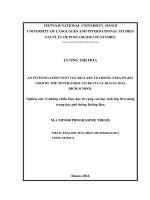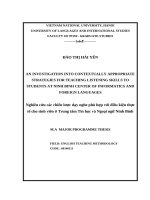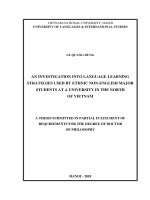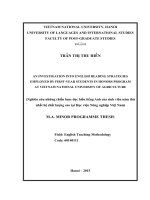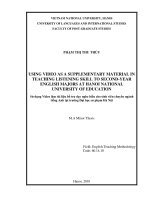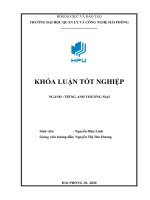Khóa luận tốt nghiệp an investigation into oral communication strategies adopted by second year english majors at vietnam national university of agriculture
Bạn đang xem bản rút gọn của tài liệu. Xem và tải ngay bản đầy đủ của tài liệu tại đây (621.88 KB, 54 trang )
VIET NAM NATIONAL UNIVERSITY OF AGRICULTURE
FACULTY OF EDUCATION AND FOREIGN LANGUAGES
BA THESIS
AN INVESTIGATION INTO ORAL
COMMUNICATION STRATEGIES ADOPTED
BY SECOND-YEAR ENGLISH MAJORS
AT VIETNAM NATIONAL UNIVERSITY OF
AGRICULTURE
KHẢO SÁT VIỆC SỬ DỤNG CÁC CHIẾN LƯỢC
GIAO TIẾP QUA KỸ NĂNG
NÓI TIẾNG ANH CỦA SINH VIÊN NĂM THỨ 2
NGÀNH NGÔN NGỮ ANH,
HỌC VIỆN NÔNG NGHIỆP VIỆT NAM
Student
: NGUYỄN AN KHÁNH
Student code : 621194
Major
: ENGLISH
Supervisor
: BÙI THỊ LÀ
Hanoi – 2021
VIET NAM NATIONAL UNIVERSITY OF AGRICULTURE
FACULTY OF EDUCATION AND FOREIGN LANGUAGES
BA THESIS
AN INVESTIGATION INTO ORAL
COMMUNICATION STRATEGIES ADOPTED
BY SECOND-YEAR ENGLISH MAJORS
AT VIETNAM NATIONAL UNIVERSITY OF
AGRICULTURE
KHẢO SÁT VIỆC SỬ DỤNG CÁC CHIẾN LƯỢC
GIAO TIẾP QUA KỸ NĂNG
NÓI TIẾNG ANH CỦA SINH VIÊN NĂM THỨ 2
NGÀNH NGÔN NGỮ ANH,
HỌC VIỆN NÔNG NGHIỆP VIỆT NAM
Student
: NGUYỄN AN KHÁNH
Student code : 621194
Major
: ENGLISH
Supervisor
: BÙI THỊ LÀ
Hanoi – 2021
CERTIFICATE OF ORIGINALITY
I, the undersigned, hereby certify my authority of the study project report
entitled an investigation into oral communication strategies adopted by
second-year English majors at the Vietnam National University of
Agriculture submitted in partial fulfillment of the requirements for the degree
of Bachelor in English Language. Except where the reference is indicated, no
other person‟s work has been used without due acknowledgment in the text of
the thesis.
Hanoi, 2021
Nguyen An Khanh
Approved by
SUPERVISOR
Bui Thi La
(Signature and full name)
Date:
/07/2021
i
TABLE OF CONTENTS
Certificate of originality....................................................................................... i
Table of contents.................................................................................................. ii
Abstract ............................................................................................................... iv
List of abbreviation ............................................................................................. v
List of tables ........................................................................................................ vi
PART I: INTRODUCTION ............................................................................... 1
1. Rationale for the study ................................................................................ 1
2. Aims and objectives of the study ................................................................ 1
3. Research questions ....................................................................................... 2
4. Scope of the study ........................................................................................ 2
5. Significance of the study .............................................................................. 2
6. Design of the study ....................................................................................... 2
PART II: DEVELOPMENT .............................................................................. 4
Chapter 1: LITERATURE REVIEW............................................................ 4
1.1. Review of previous studies ....................................................................... 4
1.2. Review of theoretical background........................................................... 7
1.2.1. Communication strategy ..................................................................... 7
1.2.4. The OCS Inventory ........................................................................... 16
1.3. Summary.................................................................................................. 19
Chapter 2: METHODOLOGY..................................................................... 20
2.1. Research methods ................................................................................... 20
2.2. Research context ..................................................................................... 21
2.3. Data collection ......................................................................................... 22
2.3.1. Data collection instrument ................................................................ 22
2.3.2. Data collection procedure ................................................................. 22
ii
2.4. Data analysis ............................................................................................ 23
Chapter 3: FINDINGS AND DISCUSSION ............................................... 24
3.1. Findings.................................................................................................... 24
3.1.1. Quantitative finding .......................................................................... 24
3.1.2. Qualitative finding ............................................................................ 31
3.2. Discussion ................................................................................................ 32
3.3. Summary.................................................................................................. 37
PART III: CONCLUSION ............................................................................... 38
1. Recapitulation ............................................................................................ 38
2. Concluding remarks on each of the thesis objectives ............................. 38
3. Limitation of the current research ........................................................... 40
4. Suggestions for further research .............................................................. 40
REFERENCES .................................................................................................. 41
APPENDICES ................................................................................................... 43
iii
ABSTRACT
Oral communication strategies are a powerful instrument for EFL learners
who would like to improve their English ability and communication skills. It is
indeed a crucial tool for students to gain an understanding of communication
techniques in EFL settings. As a result, one of this thesis was to look at the
usage frequency of oral communication strategies among English majors at the
Vietnam National University of Agriculture. In addition, as well as to propose
effective oral communication strategies that enable English majors to enhance
their communication ability. The mixed-methods design was used in this study.
The quantitative phase involved the administration of a questionnaire to 110
participants, and the qualitative phase involved 12 students who completed the
questionnaire but volunteered to participate in the follow-up interviews.
Integration of quantitative and qualitative findings of the current research
revealed
that
English-majored
second-year
students
used
eight
oral
communication strategies to help to enhance their English oral communication
competence. The study documented a few practical oral communication
strategies. The findings of this study might raise the awareness of oral
communication strategies among Vietnamese students in general and VNUA
students in particular. Combining the results of this study with those of other
studies from different settings may lead to a better understanding of oral
communication strategies.
iv
LIST OF ABBREVIATION
CS
Communication strategies
EFL
English as a foreign language
M
Mean
OCS
Oral communication strategies
OCSI
Oral Communication Strategies Inventory
SPSS
Statistical Package for the Social Sciences
St. D
Standard Deviation
VNUA
Vietnam National University of Agriculture
v
LIST OF TABLES
Table 3.1. The overall use of oral communication strategies ............................. 24
Table 3.2. Fluency Oriented strategies................................................................ 25
Table 3.3. Negotiation for meaning while speaking strategies ........................... 26
Table 3.4. Nonverbal strategies ........................................................................... 26
Table 3.5. Attempt to think in English strategies ................................................ 27
Table 3.6. Message reduction and alteration....................................................... 27
Table 3.7. Social affective strategies................................................................... 28
Table 3.8. Accuracy-oriented strategies .............................................................. 29
Table 3.9. Message abandonment strategies ....................................................... 30
Table 3.10. Achievement and Reduction strategies ............................................ 31
vi
PART I: INTRODUCTION
1. Rationale for the study
In the process of globalization, high-quality human resources was one of
the essential requirements for Vietnam. Yet, having only specialized knowledge
without a good command of English, especially speaking and listening skills,
Vietnamese human resources will face various difficulties in the job market and
the career ladder. It was the duty of universities to meet the need for a highquality workforce with proficient English communicative skills. From such
demand, English Linguistics becomes a new major at the Vietnam National
University of Agriculture (VNUA), elevating English-majored students' oral
communication competence, which was a must to increase their competitiveness
in the job market. Specifically, English was taught as a foreign language in the
context of Vietnam. Among four English skills, namely reading, listening,
speaking, and writing, most students find it challenging to study speaking and
listening skills. According to Bialystock (1990), developing the ability to use
oral communication strategies (OCS) helps learners develop communicative
proficiency to deal with their lack of knowledge of the target language. This was
a crucial tool for students who were short of speaking and listening knowledge.
Considering all the reasons above, I decided to propose a study titled "An
investigation into communication strategies adopted by second-year English
majors at the Vietnam National University of Agriculture".
2. Aims and objectives of the study
The aim of the study was to improve the second-year English majors oral
communication skills at VNUA.
The objectives of the paper were to investigate the use of OCS by Englishmajored students at Vietnam National University of Agriculture and to suggest
effective OCS for English majors to improve their oral communication ability.
1
3. Research questions
What were the oral communication strategies used in English
communication by English-majored second-year students at VNUA?
What suggestions should be given to improve English majors‟ oral
communication skills at VNUA?
4. Scope of the study
The study lasted 4 months from 01/03/2021. The author carried out an
investigation into the use of OCS with 110 second-year English-majored
students from the Department of Education and Foreign Languages at VNUA.
The study explored the use of OCS among English Linguistics second-year
students. In detail, the study focuses only on OCS to cope with problems while
speaking.
5. Significance of the study
Achieving specialized knowledge and proficient English communication
competence at the same time was not an easy task for many students. In many
means to develop communication ability, using OCS was a tool that was not
limited by the target language knowledge of users. The impact of OCS on
second language or foreign language acquisition in general and English as a
foreign language, in particular, has been proven by many scholars to
successfully deal with communication difficulties. This was a valid reason for
OCS to be compulsory knowledge for VNUA students in particular and students
in general. By conducting this research, first, we hope to raise students‟
awareness of OCS, and second, this study was also expected to become a useful
reference resource for fellow students as well as other researchers.
6. Design of the study
Apart from abstracts, references and appendices, the study consists of three
main parts:
2
Part I - Introduction presents the rationale, aims and objectives of the study,
research questions, and the scope of the study as well as the significance of the
study.
Part II - Development was divided into 3 chapters:
Chapter 1 - Literature review provides the theoretical background for the
study.
Chapter 2 - Methodology describes the research type and the methods used
in the study including the research context, data collection instruments and
procedures, and data analysis.
Chapter 3 - Findings and discussions report and discuss the findings of the
study.
Part III - Conclusion summarizes the main issues that have been addressed
in the study, points out the limitations and suggests recommendations for further
study.
3
PART II: DEVELOPMENT
Chapter 1: LITERATURE REVIEW
1.1. Review of previous studies
A large and growing body of literature has examined OCS. First being
recognized in the 1970s by Selinker, OCS has rapidly become a fascinating
research topic. Numerous researchers have proven that OCS were crucial
language tools. In Vietnam, studies on the effect of OCS only started to emerge
after a decade following the Doi Moi policy from the mid-2000s to the 2010s.
An article with the title “A study on strategies used in verbal
communication between native English and non-native speakers in the
workplace” by Vu Thi Bich Hiep M.A published on Language and Life
Magazine No. 5 (235) in 2015 was an example of research conducted in
Vietnam. This paper has argued that non-native speakers (Vietnamese) tended to
omit subjects (i.e. “I”, “we”) and only use keywords or key phrases to
communicate in English. Additionally when facing communication difficulties,
they often reduced their message or repeated themselves. White lies, Yes/No,
ambiguous expressions, and filler words were the answers of a large number of
Vietnamese participants in this research. In her discussion, 3 strategies were
suggested to help the non-native speakers understood received messages, which
were explaining and summarizing strategies, asking questions strategies, and
requesting repetition or spelling strategies. In the end, Vu concluded that the two
main purposes of verbal communication in the workplace were exchanging
information and establishing a relationship, and integrating into an
internationalized working environment helps Vietnamese office workers be
more flexible, have better communication skills, and be more adaptable.
In a recent study by Le Van Tuyen et al. “Strategies used by undergraduate
English-majored students in oral communication” published on VNU Journal of
Foreign Studies, Vol.36, No.1 (2020) 156-170, they conducted this research on
4
second-year students, juniors, and seniors at Ho Chi Minh University of
Technology (HUTECH) with the purposes of exploring the most commonly
used strategies among English majors and differences in the use of strategies in
oral communication among three academic levels. Adapted from the Oral
Communication Strategy Inventory (Nakatani, 2006) in their study, the paper
has reported that the strategies which English-majored Students at HUTECH
used most frequently while speaking in English oral communication was the
“fluency-oriented strategies”. And among three academic levels from secondyear students to seniors, it was stated that “the findings of the study revealed that
there were no significant differences in the use of OCS among the participants”.
Most participants reported that solving the problem was regarded as more
effective than evading it when it comes to preventing communication
breakdowns. Finally, Tuyen and his partners suggested similar studies should
take place at other universities in Vietnam or in another context since the results
were only true to the specific conducted site.
Another article on the use of OCS by students in a non-English-majored
context was published in TNU Journal of Science and Technology 225(03) in
the same year. The title of this article was “The use of OCS in different speaking
tasks by the first-year students at Thai Nguyen University of Agriculture and
forestry” by Vu Kieu Anh. This paper, therefore, demonstrated her research on
30 first year Forestry-majored students with aims to find out types of OCS
employed by the students while doing a speaking task and whether they use
different types of strategies in one-way and two-ways tasks. In her detailed
investigation, Anh concluded that participants mainly employed modification
devices in the one-way task the same as the two-way task by adapting Willems
(1987) classification. It was reported that “4 subtypes of CS that were topic
avoidance, direct asking, foreignizing, and mime were not employed by the
5
students in this study” and while performing two tasks, the students also used a
wide range of OCS types.
Outside of Vietnam, during the past half-century, many studies have been
conducted from general theories to case studies in specific contexts. Much more
information has become available since the 1980s such as definition,
taxonomies, relation, etc. In an article on the modern language journal published
in 2006, “Developing an OCS Inventory”, Nakatani has provided an OCS
inventory that distinguished strategies used while speaking and while listening.
In 2015, Springer Second Language Learning and Teaching published
“OCS Used by Turkish Students Learning English as a Foreign Language” by
Şaziye Yaman and Mehtap Özcan. The context of this literature was at the
English Teaching Department of Mersin University. They reported that
negotiation for meaning and compensatory strategies were the most frequently
used strategies. In contrast, message abandonment strategies were ranked at the
bottom of their chart and were more commonly used by intermediate students
than advanced students. In the end, Yaman and Özcan concluded that
negotiation for meaning strategies, compensatory strategies, and affective
strategies was considered effective in helping students overcome communication
problems whereas the less effective ones were message abandonment strategies
and planning/organizing strategies. They also stated that “the findings of the
current study were restricted to the perceptions of the students, but strategy use
could also change according to the speaking tasks in which students were
engaged.” The authors suggested that other research should be conducted in a
dissimilar context for a different outcome.
Another article with the title “Exploring the Use of OCS by High and Low
Proficiency learners of English: Tunisian EFL students as a case study” by
Tesnim Ounis was published in the International Journal of Humanities and
Cultural Studies ISSN 2356-5926 in 2016. 100 second-year students at the
6
Higher Institute of Languages in Gabes, Tunisia took part in this research.
Exploring OCS use among English as Foreign Language learners following the
OCS Inventory (Nakatani, 2006) was what it aimed at. Ounis has shown in the
article that the top three popular OCS used by participants were negotiation for
meaning strategies, social effective strategies, and message reduction and
alteration strategies, respectively. The different use of OCS based on proficiency
was described as follows: achievement strategies were significantly reported by
high proficiency learners, on the contrary low proficiency learners often use
reduction strategies.
In general, previous literature has predominantly presented the use of OCS
in particular contexts and successfully answer their research questions. Many
studies have pointed out that the finding of this topic may vary between different
situations. Consequently, OCS will remain an interesting topic for many
researchers.
1.2. Review of theoretical background
1.2.1. Communication strategy
It has been reported from several sources that communication was the
exchange of information between at least one sender and one receiver. David
Crystal (2008) identified communication as “a fundamental notion in the study
of behavior, which acts as a frame of reference for linguistic and phonetic
studies. Communication refers to the transmission and reception of information
(a „message‟) between a source and a receiver using a signaling system: in
linguistic contexts, source and receiver were interpreted in human terms, the
system involved was a language, and the notion of response to (or
acknowledgment of) the message becomes of crucial importance.”
Strategy was a term mentioned in every field from science to art such as
military, politics, business, etc. The Merriam-Webster Dictionary states “the
science and art of employing the political, economic, psychological, and military
7
forces of a nation or group of nations to afford the maximum support to adopted
policies in peace or war”. Despite the fact that the term itself carrying different
meanings was an adaptation or complex of adaptations (as of behavior,
metabolism, or structure) that serves or appears to serve an important function in
achieving evolutionary success also from the Merriam-Webster Dictionary.
Bui (2016, citing Tarone, Cohen, and Dumas, 1976) described CS as
language learners‟ problem-solving behavior in learning a second or foreign
language. In their analysis, they pointed out that learners tended to use OCS to
compensate for adversities stemming from the lack of appropriate target
language knowledge. Tarone (1980) revisited and updated the definition of CS
by “CS were considered to be an interactional phenomenon; mutual attempts of
two interlocutors to agree on a meaning in a situation where the requisite
meaning structures do not seem to be shared”.
As Ounis (2016, citing Canale and Swain, 1980) implied CS was a crucial
component of strategic competence. In the 1980s, it set the trend for researching
OCS in the foreign language learning field. Another remarkable book named
“Strategies in interlanguage communication” by Færch and Kasper was
published at this time, which summarized previous studies on OCS and later laid
the foundation for the following research on CS.
After the concept of CS was presented by Selinker (1972) for the first time
as dictating to language learners who “know enough of the target language in
order to communicate”, a number of theoretical frameworks and definitions of
CS have become available. Based on dissimilarities in classification and
taxonomies, this information has been divided into myriad views. The reviewed
literature only involves the interactional perspective and psycholinguistic
perspective, which were introduced by Tarone in 1984 and Færch and Kasper in
1983.
8
Not satisfied with the last definition, Tarone (1984) redefined CS as a joint
attempt made by two interlocutors” to negotiate on an agreed meaning and to
narrow the gaps between linguistic knowledge where “their meaning structures
do not seem to be shared” in terms of different language background. The
interactional slant was introduced where learners arrange to make certain that
“interactants were talking about the same thing” (Tarone, 1984). It focuses on
the way language learners use CS to interact and negotiate meaning effectively
with one another.
For Faerch and Kasper (1983), CS were “mental plans implemented by the
L2 learner in response to an internal signal of an imminent problem, a form of
self-help that does not require support from the interlocutor for resolution, such
as asking for help and negotiating for meaning”. What was significant about the
following definition was that it allows the writers to initiate CS with regard to
the individual‟s mental responses to a problem rather than as a response by two
people. On that account, this identified CS as potentially conscious plans to
solving a problem in reaching communication goals (Faerch, 1983). This
definition indicates that goal-oriented intellectual behavior‟s principle model
was applied since OCS could be assumed as a goal-oriented verbal plan. The
model consists of two consecutive stages: a planning stage entailed a goal,
planning process, and plan while an execution stage contained the plan,
execution process, and action; language learners would come up with the most
appropriate plan and it would be executed to satisfy the original goal (Faerch,
1983). Faerch and Kasper introduced the psycholinguistic angle that solely
focused on the mental process and behavior within language learners. Therefore
Following these two standpoints, varying definitions of CS have emerged
in the 1980s (Rababah, 2002). The two notable cases of definition variation were
Poulisse (1984) and Brown (1987). Poulisse based on Faerch (1983) argued that
when a language user becomes aware of issues emerging during the planning
9
phase of an utterance owing to his own linguistic shortcomings, he uses
compensatory methods to accomplish his intended meaning. (Poulisse et al.,
1984 and 1990). This definition focused on the planning stage of communication
but did not mention the consciousness of strategies. Adapting the separation
between verbal and non-verbal CS (Canale, 1980), Brown emphasized the
consciousness of CS as when exact language forms were not available to the
learner at that time in communication, hence the conscious use of verbal or
nonverbal methods to communicate a thought. (Brown, 1987).
Nevertheless, Faerch and Kasper‟s definition seemed to be more extensive
than others since it did not completely prohibit marks of CS on the interaction
between interlocutors and whether the strategies users share the first language or
not.
All the previously mentioned definitions could be inferred that
problematicity and consciousness were the key criteria for CS. In the
consciousness case, the majority of scholars came to the conclusion that it
should be split into smaller degree criteria. Bialystok (1990) separated it into
consciousness and intentionality referred to as “learner‟s control over a
repertoire of strategies so that particular ones may be selected from the range of
options and deliberately applied to achieve certain effects”. Later, Dörnyei, and
Scott (1995) categorized it further into four aspects of consciousness, three of
which were important in a problem-solving device: consciousness as awareness
of the problem, consciousness as intentionality, and consciousness as awareness
of strategic language use, it was a strategy. The fourth aspect – consciousness as
control was not claimed as a defining criterion by Dörnyei and Scott because “an
automatized strategy could be considered a CS proper, particularly because one
purpose of CS training was to enhance automatization”; this was the adoption of
Fỉrch and Kasper‟s definition “potentially conscious”. (Dưrnyei, 1997)
10
The meaning of this term has evolved over time. OCS were defined by Ellis
(1994) as the tactic which language learners utilized to cope with interlingual
resource deficiency. The term CS was used by Dörnyei (1995, 1997) to refer to a
tool to deal with communication breakdown and to communicate more
effectively. Le et al (2020) drew the work of Maleki (2007) who suggested that
“CS were related to individual language users‟ experience of communicative
problems and solutions they pursue, and to an individual‟s attempt to find a way
to fill the gap between their communication effort and immediate available
linguistic resources”.
Reviewing the previous studies, CS could be understood as an act or a plan
used by a learner, with or without the support of other interlocutors, to overcome
communicative challenges and to avoid communication breakdown. The author
chose to use the mentioned
1.2.2. Oral Communication Strategies
The term Oral Communication Strategies (OCS) was chosen in the
inventory rather than communication strategy (CS) “in order to avoid terms that
might exacerbate the confusion regarding taxonomies, the term oral
communication strategy (OCS) was used instead of communication strategy”
(Nakatani, 2006). Nakatani (2006) was apparently the first to define the term
OCS as “specifically focus on oral interaction and interlocutors‟ negotiation
behavior for coping with communication breakdowns”. In a well-designed
review in the next year, Nakatani and Goh (2007, cited in Bui, 2016), two
authors from Japan, adapted data from works of literature from not only the
interactional view but also the psycholinguistic one and provided a new
definition for OCS. They concluded “OCS were strategies that language learners
use to help them interact with others orally and also help them overcome gaps of
linguistic knowledge during the interaction” (Nakatani and Goh, 2007). Since
then there was no new definition that focused on only the oral interaction. This
11
definition was adopted by many prior papers: Huang (2010), Yaman (2015),
Ounis (2016), Bui (2016), Rastega (2016), Chairat (2017), and Le et al (2020).
1.2.3. Taxonomies of communication strategies
A great volume of research has been contributed to identifying and
classifying OCS. As mentioned above, researchers showed a tendency to follow
an interactional perspective or psycholinguistic one and even mixed these two in
some cases, leading to the development of various taxonomies. The literature
reviews only identified 5 different taxonomies that were constructed by Tarone
(1984), Færch and Kasper (1983), Bialystok (1983), Dörnyei (1995), and
Nakatani (2006).
Tarone (1984) categorized OCS as follow:
a) Paraphrase
i) Approximation
ii) Word coinage
iii) Circumlocution
b) Borrowing
i) Literal translation
ii) Language switch
iii) Appeal for assistance
iv) Mime
c) Avoidance
i) Topic avoidance
ii) Message abandonment
This taxonomy was an updated version of Tarone (1977) which consisted
of five groups of strategies: avoidance, paraphrase, conscious transfer, appealing
for assistance, and mime. „Paragraph‟ was stated in Tarone (1977) as “the
rewording of the message in an alternate, acceptable target language
construction, in situations where the appropriate form or, construction was not
12
known or not yet stable”. Within Paraphrase, there were three strategies:
approximation, word coinage, and circumlocution. „Borrowing‟ was the
combination of three sub-groups: appealing for assistance, mime, and conscious
transfer which was split into literal translation and language switch. The last
group included topic avoidance and message abandonment. Tarone discussed
that message abandonment was the effort to terminate the message after failing
to convey the message and thus seen as a strategy. In addition, he stated that
topic avoidance remained a complicated case.
Færch and Kasper (1983) examined the interlocutor‟s behavior when
encountering a communication problem. Target language users choose to avoid
the intricacy ergo avoidance behavior or attempt to handle the hardship ergo
achievement behavior. Their taxonomy was built on the basis of these two
behaviors with reduction strategies formed on avoidance behavior and
achievement strategies based on achievement behavior.
A) Reduction strategies
a) Formal reduction
i) Phonological
ii) Morphological
iii) Syntactic
iv) Lexical
b) Functional reduction
i) Actional reduction
ii) Modal reduction
iii) Reduction of the propositional content:
· Topic avoidance
· Message abandonment
· Meaning replacement
B) Achievement strategies
13
a) Compensatory strategies:
i) Code-switching
ii) Interlingual transfer
iii) Inter-/intralingual transfer
iv) Generalization
v) Paraphrase
vi) Word coinage
vii) Restructuring
viii) Cooperative
ix) Non-linguistic
b) Retrieval strategies
Each group of this taxonomy carried two sub-categories that refer to the
specific situation they would be used. When learners were concerned with
correctness or fluency, strategies of informal reduction would take place. When
the intended communicative goal was reduced or abandoned, functional
strategies would be employed. When learners attempted to find a solution and
keep the original communicative goal, he/she would use achievement strategies
(Bui, 2016). The systems of classification by Tarone (1984) and Færch and
Kasper‟s (1983) was of great use as it provided the basis for following
researchers.
Bialystok (1983) took another approach and proposed a taxonomy that was
based on the source of information used to solve the communication
complication.
a) Ll-based strategies
i) Language switch
ii) Foreignizing
iii) Transliteration
b) L2-based strategies
14
i) Semantic contiguity
ii) Description
iii) Word coinage
The sources of information could come from first language, second
language, or paralanguage. Rababah (2002, citing Bialystok, 1980) noted „Llbased strategies include switching, foreignizing and literal translation. Language
switch was the "insertion of a word or a phrase in a language other than the
target language, usually, the learner's native language", whereas foreignizing
was the creation of non-existent or inappropriate target language items "by
applying L2 morphology and/or phonology to L1 lexical items"‟. Hence, the L2based strategies were adapted from Tarone (1983).
Dörnyei (1995) oversaw the previous papers and agreed that there were two
big
categories,
which
were
avoidance/reduction
strategies
and
achievement/compensatory strategies. According to his paper, he formed the
definitions of the former as modifying, diminishing, or completely discarding
the original content. These methods were employed to adjust one's message to
one's listeners. Achievement/compensatory strategies try to “convey the
intended message” despite linguistic limitations by expanding or manipulating
the speaker‟s existing language system (Dörnyei, 1997). He also proposed a
third one – stalling/time-gaining strategies.
a) Avoidance/ Reduction strategies
i) Message abandonment
ii) Topic avoidance
b) Achievement/ Compensatory strategies
i) Circumlocution
ii) Approximation
iii) Use of all-purpose words
iv) Word-coinage
15
v) Use of non-linguistic means
vi) Literal translation
vii) Foreignizing
viii) Code-switching
ix) Appeal for help
c) Stalling/ Time-gaining strategies
i) Use of fillers
Dörnyei (1995) was a pioneer in recognizing the usefulness and
effectiveness of using filler which was “words or phrases used to fill pauses, to
cover for hesitation, gain time, and provide smooth transformation in
breakdowns”. He argued that this third strategy enabled the speaker to “gain
time to think and keep their conversation open at times of difficulties” (Dörnyei,
1995), which might fall under the category of problematicity. Therefore,
Dörnyei broadened the scope of OCS by involving stalling strategies.
It was not until the 2000s when Nakatani (2006) developed the OCS
Inventory - a taxonomy only focusing on oral communication. The inventory
was a classification system used to codify OCS according to the basic principle
of a conversation: speaking and listening. Following the interactional
perspective, this taxonomy addressed directly which OCS should be used when
issues occur while listening and speaking. This was a unique feature that no
previous authors had identified.
1.2.4. The OCS Inventory
Interlocutors' negotiating behavior in dealing with communication failures
and their usage of communication enhancers were highlighted in OCS. The
OCSI was made up of 58 items and divided into two parts. Still, each part
carries the traits of two big classes that Nakatani (2006) refer to them
differently, achievement as “good learner” behaviors and reduction as “lowproficiency learner” behaviors. Since this paper only concerns the speaking
16
aspect of OCS, the strategies for coping with speaking problems were focused,
in which only message abandonment strategies run with “low-proficiency
learner” behavior. The strategies were listed as follow:
i) Social-affective: involve learners‟ affective factors in social contexts.
ii) Fluency-oriented was related to the fluency of communication.
iii) Negotiation for meaning while speaking: were relevant to the
participants‟ attempts to negotiate with their interlocutors
iv) Accuracy-oriented: were concerned with a desire to speak English
accurately.
v) Message reduction and alteration: involve avoiding a communication
breakdown by reducing an original message, simplifying utterances, or using
similar expressions that could be confidently used.
vi) Non-verbal strategies while speaking: require using eye contact,
gestures, or facial expressions to give hints and to help the listener guess the
intended meaning.
vii) Message abandonment: were associated with message abandonment by
learners in communication.
viii) Attempt to think in English involves thinking as much as possible in
the foreign language during actual communication. The importance of these
strategies was that oral communication usually requires a quick response to
interlocutors.
The first part includes 8 sub-categories with 32 variables for dealing with
the problem while speaking and the other part consists of 7 sub-categories with
26 variables for dealing with a problem while listening. Being considered a new
taxonomy, the OCSI with the Cronbach‟s alpha of strategies for coping with a
problem when speaking at .86 and strategies for coping with a problem when
listening at .85, which indicates a highly acceptable internal consistency. This
was the reason why many researchers chose to employ the OCSI in their
17
